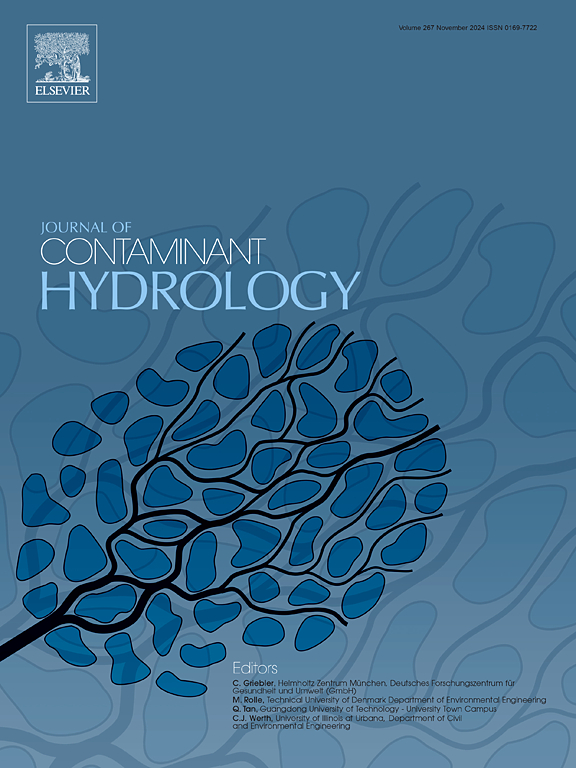水冷系统温度升高对粘土衬垫中污染物运移的影响:实验室和数值研究
IF 3.5
3区 环境科学与生态学
Q2 ENVIRONMENTAL SCIENCES
引用次数: 0
摘要
在城市生活垃圾填埋场(MSWL)中,由于垃圾的生物降解作用,基底压实粘土衬垫(CCL)的中心和外围区域经常经历稳定的升温,循环温度与季节性大气温度模式相似。在本研究中,通过将CCL样品置于不同干燥温度的多个干湿循环中,研究了循环升高温度对MSWL基底CCL干燥行为的负面影响。结果表明,随着干燥温度和干湿循环次数的增加,CCL的干燥开裂程度增大。本研究还评估了不同热塑性冷却管对减少暴露于恒定高温(CETs)的ccl经历的升温和干燥的影响。我们观察到,热塑性冷却管的引入导致了最终温度(FT)的显著衰减和干燥幅度沿CCL深度在面对所有应用的CETs,而不管所采用的冷却管材料。通过数值模拟对整个覆铜板、冷却剂和冷却管周围砂层的最终温度分布进行了全面分析。总的来说,本研究揭示了循环升高温度对覆铜板的不利影响,以及热塑性冷却管在面对不同cet时成功减少覆铜板温度升高和干燥的潜力。本文章由计算机程序翻译,如有差异,请以英文原文为准。

Impact of elevated temperature from water cooling system on contaminant transport in clay liners: A laboratory and numerical investigation
In municipal solid waste landfills (MSWL), the center and peripheral regions of the basal compacted clay liner (CCL) often experience steady elevated temperatures due to waste biodegradation and cyclic temperatures similar to the seasonal atmospheric temperature patterns, respectively. In the present study, the negative effects of cyclic elevated temperatures on the desiccation behaviour of a MSWL basal CCL was examined by subjecting CCL samples to multiple wet-dry cycles with different drying temperatures. It was observed that the extent of desiccation cracking experienced by the CCL rose as the drying temperature and number of wet-dry cycles increased. The present study also assessed the effect of different thermoplastic cooling pipes on the reduction of temperature rise and desiccation experienced by CCLs exposed to constant elevated temperatures (CETs). It was observed that the introduction of thermoplastic cooling pipes led to a significant attenuation of the final temperature (FT) and desiccation magnitude along the CCL depth in the face of all applied CETs, irrespective of the cooling pipe material employed. A comprehensively analysis of the final temperature distributions within the entire CCL, coolant and sand layer surrounding the cooling pipe was also carried out via the conduction of a numerical simulation. Overall, the present study revealed the adverse effects imposed by cyclic elevated temperatures on a CCL and the potential that thermoplastic cooling pipes possess to successfully reduce the temperature rise and desiccation experienced by a CCL in the face of different CETs.
求助全文
通过发布文献求助,成功后即可免费获取论文全文。
去求助
来源期刊

Journal of contaminant hydrology
环境科学-地球科学综合
CiteScore
6.80
自引率
2.80%
发文量
129
审稿时长
68 days
期刊介绍:
The Journal of Contaminant Hydrology is an international journal publishing scientific articles pertaining to the contamination of subsurface water resources. Emphasis is placed on investigations of the physical, chemical, and biological processes influencing the behavior and fate of organic and inorganic contaminants in the unsaturated (vadose) and saturated (groundwater) zones, as well as at groundwater-surface water interfaces. The ecological impacts of contaminants transported both from and to aquifers are of interest. Articles on contamination of surface water only, without a link to groundwater, are out of the scope. Broad latitude is allowed in identifying contaminants of interest, and include legacy and emerging pollutants, nutrients, nanoparticles, pathogenic microorganisms (e.g., bacteria, viruses, protozoa), microplastics, and various constituents associated with energy production (e.g., methane, carbon dioxide, hydrogen sulfide).
The journal''s scope embraces a wide range of topics including: experimental investigations of contaminant sorption, diffusion, transformation, volatilization and transport in the surface and subsurface; characterization of soil and aquifer properties only as they influence contaminant behavior; development and testing of mathematical models of contaminant behaviour; innovative techniques for restoration of contaminated sites; development of new tools or techniques for monitoring the extent of soil and groundwater contamination; transformation of contaminants in the hyporheic zone; effects of contaminants traversing the hyporheic zone on surface water and groundwater ecosystems; subsurface carbon sequestration and/or turnover; and migration of fluids associated with energy production into groundwater.
 求助内容:
求助内容: 应助结果提醒方式:
应助结果提醒方式:


